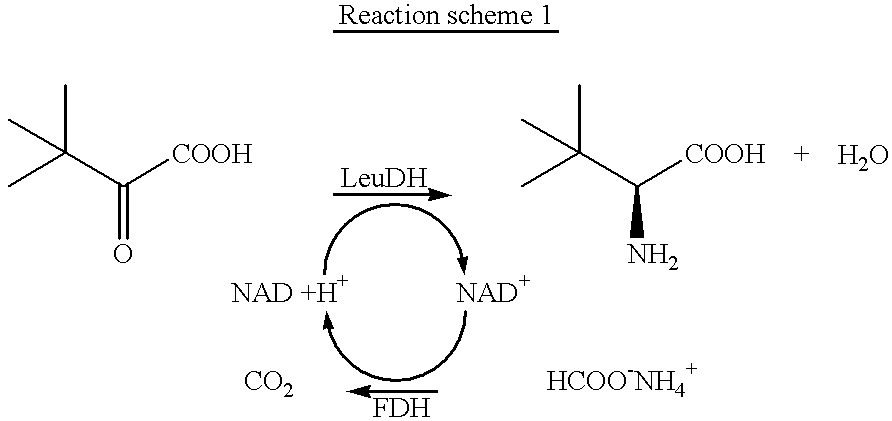Mutants of formate dehydrogenase from Candida boidinii, new gene sequences encoding these and use of the new formate dehydrogenases
a technology of formate dehydrogenase and gene sequence, applied in the field of new gene sequences encoding these, can solve the problems of inability to use the process mentioned above economically viable for industrial use, high cost of coenzyme, and continued addition of fdh
- Summary
- Abstract
- Description
- Claims
- Application Information
AI Technical Summary
Benefits of technology
Problems solved by technology
Method used
Image
Examples
example 1
Preparing Genomic DNA from Candida boidinii
Preparing genomic DNA from the yeast was performed using a modified form of Ferbeyre et al.'s method (Bio Techniques 1993, 14, 386). The Candida boidinii cells were cultivated in 200 ml of YEPD medium at 30.degree. C. and 200 rpm up to the time of the late logarithmic growth phase and then harvested by centrifuging (10 min, 15.degree. C., 5000 rpm, GSA rotor). Under these conditions, about 2.0 g of moist cell material were produced per 100 ml of culture. The cells were washed once with 10 mM citrate phosphate buffer, pH 7.5, and then resuspended in 10 ml of lysis buffer. 1 mg of protease [Qiagen] and 200 units of lyticase from Arthrobacter luteus [Sigma] per ml of lysis buffer were added to the cell suspension. The suspension was incubated for 60 min at 37.degree. C. and then extracted with the same volume (vol.) of phenol / chloroform / isoamyl alcohol (PCl). After centrifuging for 30 min at RT and 12000 rpm in a SS34 rotor, the aqueous phase ...
example 2
Amplifying the FDH Gene Using PCR Starting from Genomic DNA
All PCR batches were covered with a layer of 50-100 .mu.l of light mineral oil [Sigma] and PCR was performed using an automatic DNA thermal cycler [Robocycler, Stratagene] in accordance with the following programme:
PCR programme:
2 min. denaturation at 94.degree. C. (1 x at start of programme)
1 min denaturation at 94.degree. C.
1.5 min. annealing of primer at 46-60.degree. C. (depending on the melting point of the primer)
1.5 min. extension at 72.degree. C. (to extend primer by means of Taq polymerase) cyclic repetition of last three steps (25-30 x)
10 min. extension at 72.degree. C. to ensure that all the amplified fragments are fully extended.
The PCR mixture contains.
100 ng of gDNA
20 pmol of primer N-TermF3
20 pmol of primer C-TermR5
0.2 mM each of dNTPs
0.5 .mu.l of Taq polymerase (Boehringer)
10 .mu.l of buffer 10x (Boehringer)
ad 100 .mu.l with dist. water
Annealing temperature: 48.degree. C., 35 cycles
The PCR fragment was ligate...
example 3
Preparing Mutants FDH-C23S
The point mutants of FDH were produced on the basis of the cloned FDH gene (pUC-FDH) (see example 1) using Ho et al.'s method (Gene 1989, 77, 52-59). The following "internal" oligonucleotide primers, which contained both the mutations, were used:
internal primer for introducing C23S mutation:
S23sense, 5'-TTTTCAGTAGMCCATATAA-3' (SEQ ID NO:33)
S23antisense: 5'-TATATGGTTCTACTGAAAAT-3' (SEQ ID NO:34)
The following oligonucleotide primers were used as "external" primers:
PUC181S: 5'-CGCGCGTTTCGGTGATGACG-3' (SEQ ID NO:35)
C-TermR5 / Pstl: 5'-CTGCAGTTATTTCTTATCGTGTTTACCGTA-3' (SEQ ID NO:36)
N-TermF3IEcoRl: 5'-GAATTCATGAAGATTGTCTTAGTTCTTTAT-3' (SEQ ID NO:37)
1. Preparation of individual fragments:
Mixture A: Preparing SER23S1-CTERMR5 / Pstl --fragments (1.0 kb)
100 ng pUC-FDH (1.1 kbFDH-EcoRl / Pstl in pUC18)
30 pmol of primer SER23SI
30 pmol of primer CTERMR5 / Pstl
1.5 .mu.I of Pfu-polymerase (2.5 U / .mu.l)
1 / 10 vol polymerase buffer 10x
0.2 mM each of dNTP
ad 100 .mu.l with dist. water...
PUM
| Property | Measurement | Unit |
|---|---|---|
| pH | aaaaa | aaaaa |
| pH | aaaaa | aaaaa |
| pH | aaaaa | aaaaa |
Abstract
Description
Claims
Application Information
 Login to View More
Login to View More - R&D
- Intellectual Property
- Life Sciences
- Materials
- Tech Scout
- Unparalleled Data Quality
- Higher Quality Content
- 60% Fewer Hallucinations
Browse by: Latest US Patents, China's latest patents, Technical Efficacy Thesaurus, Application Domain, Technology Topic, Popular Technical Reports.
© 2025 PatSnap. All rights reserved.Legal|Privacy policy|Modern Slavery Act Transparency Statement|Sitemap|About US| Contact US: help@patsnap.com

